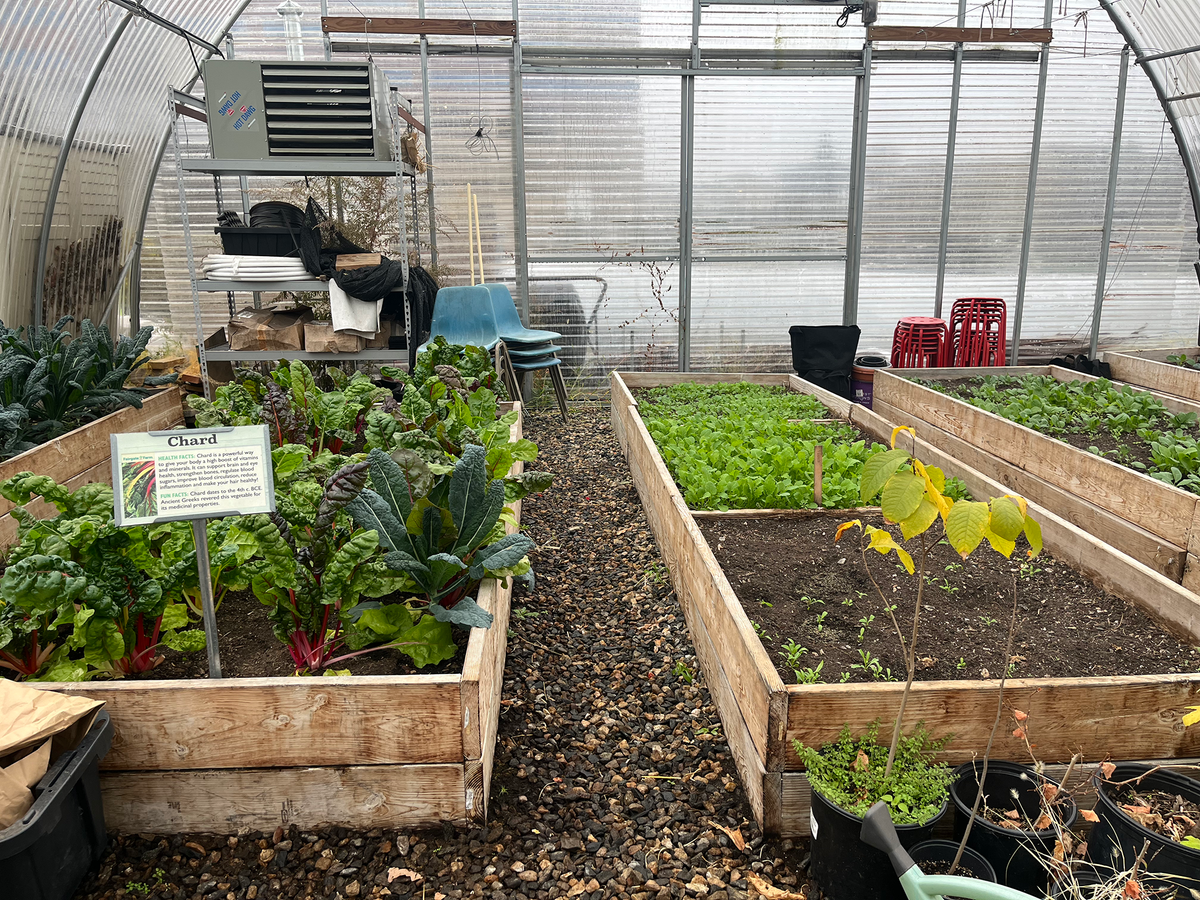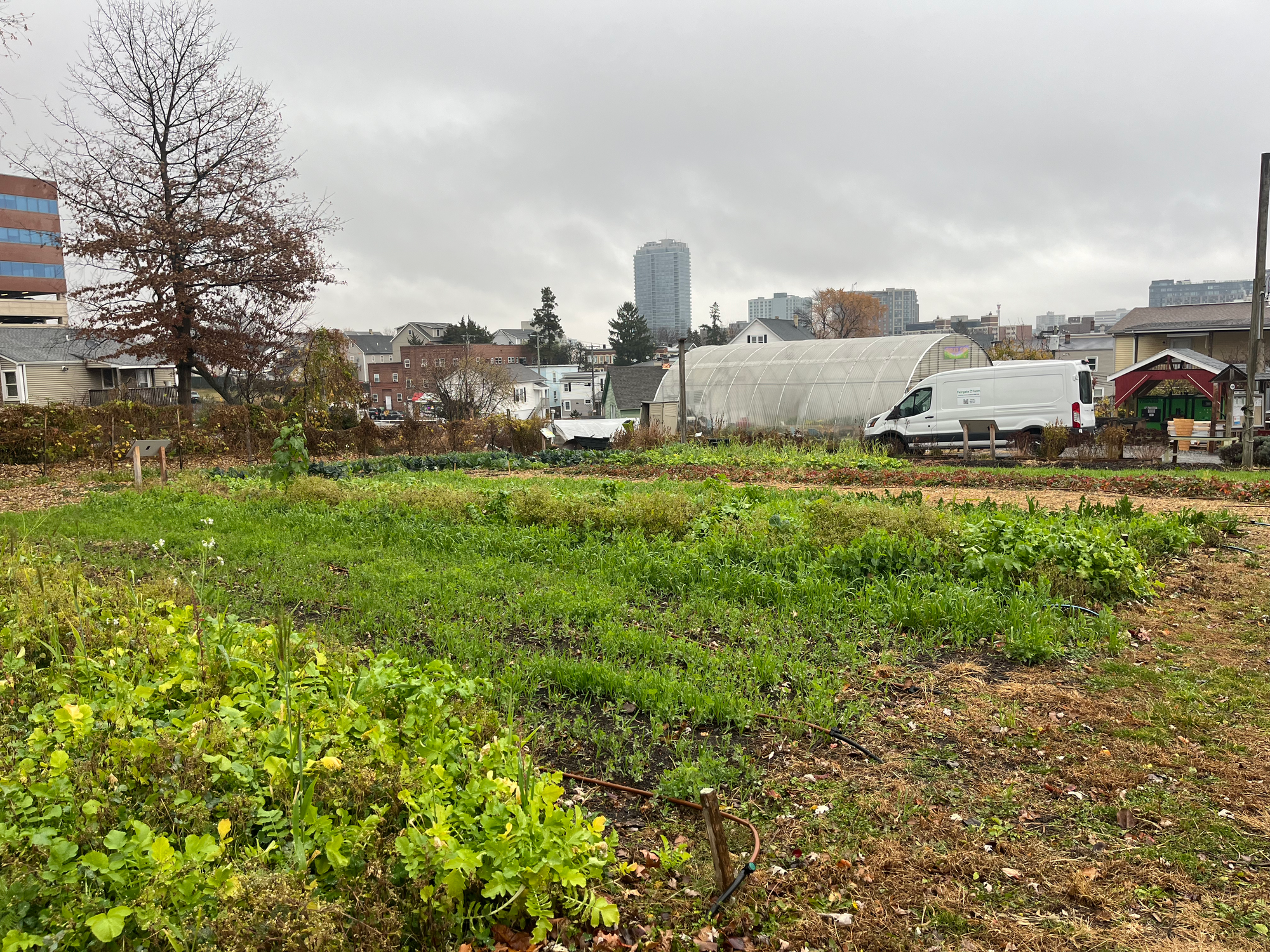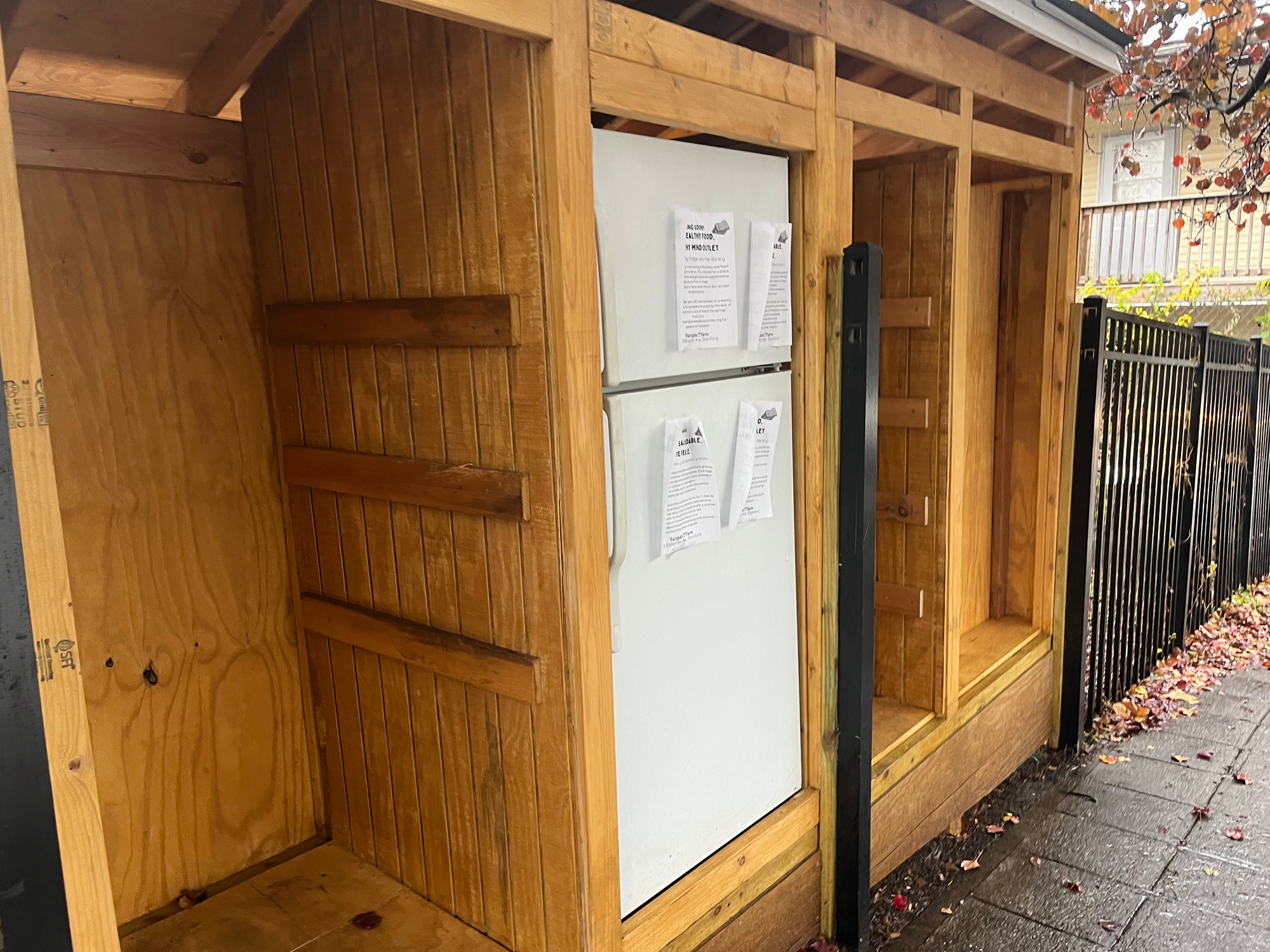Feeding their Community: How Bridgeport, Stamford, and Norwalk Groups Are Making Food Accessible
From community fridges to urban gardens, from farmers markets to food pantries, local organizations in Bridgeport, Stamford, and Norwalk are fighting back against food insecurity and access.

On a wet November day, Liz Wimpfheimer, assistant farm manager, walked up and down the rows of produce at Fairgate Farm. The farm grows a little bit of everything: from chard to eggplant, peaches to plums, peppers to mint.
But this farm, which produces thousands of pounds of food each year, wasn’t located in a rural corner of the state. It’s located on less than an acre of land along Stillwater Avenue in Stamford, in the shadow of Stamford Hospital, just blocks from the city’s downtown.
The farm aims to increase access to locally grown produce and provide fresh options, particularly for low-income residents who struggle with food insecurity and access.
“This area is considered a food desert and it can be hard to access healthy, fresh produce,” she said. “And we’ve always grown things using organic practices, so this is really healthy, nutrient-rich food—it’s different than what you might find in the grocery store.”
Fairgate Farm’s efforts are just one example of how local groups, nonprofits, and individuals are working to tackle food access and food insecurity across southwest Connecticut. Let’s explore a few.
Bridgeport: A Leader for Food Justice Innovation
Bridgeport has the highest rate of food insecurity in our region, is home to the most neighborhoods that are considered food deserts, and has the lowest life expectancy of any municipality. But it’s also home to many local individuals, business owners, and nonprofits who are looking for new ways to provide healthy food to residents in need.
nOURish Bridgeport
When Rev. Sara Smith came to the United Congregational Church in Bridgeport in 2009, she started asking members of her community what they needed.
“What they said was, ‘We need access to food. We need healthy food. We need hot meals. We need friendship, we need hope,’” she recalled. “So I was like, ‘OK, let’s get to work.’”
That inspired Smith to create nOURish Bridgeport, a nonprofit that aims to help address food insecurity in the city through a food pantry, hot meal distribution, classes, and more.
The organization has grown to serve 14,000 pounds of food a week through its food pantry, which Smith noted offers a shopper’s choice, so those who visit can choose the food that’s best for them.
“It’s a heavily African American community on the East Side of Bridgeport, so we grow collard, we grow swiss chard—it’s delicious because the residents know what to do with that,” she said. “Food is cultural so we want to make sure we have rice and beans for all of our Hispanic and Latino families that come in. We’re really sensitive if we have beef and pork—we make sure they don’t touch and we make sure our Muslim and Jews know that.”
Tshon Davis, the nonprofit’s super food pantry and volunteer director, also works to use donations they’ve received to buy produce to make sure they have a variety of options.
“We're going to buy fruit, she's buying veggies this week at Restaurant Depot, because we want to make sure we don't just give carbs—we always have a nice selection of fresh produce,” Smith said. “We work with the local farms for the apples and squash, and so we support farmers, but we get it to our neighbors, because the other issue of Bridgeport is we are a food desert.”
nOURish provides about 300 hot meals weekly on Thursday to those who are homeless. In addition, two years ago, nOURish opened an indoor hydroponic farm, the first nonprofit indoor hydroponic farm in the state.
“Hydroponic farming is the future [of farming] in an urban setting because the land is contaminated—Bridgeport has all this land and you can’t even walk on it because it’s so contaminated from the old metal factories and whatnot,” she said. “But this you just need water, light, and nutrients—no dirt, no chemicals ever.”
Smith said it has produced more than 14 tons of fresh produce since it was opened.
“We grow 25 varieties of greens and lettuces, and also now cucumbers and tomatoes—and we’re distributing it at food pantries, soup kitchens, schools, and hospitals and all sorts of places,” she said.
Smith emphasized that they partner with many local groups and organizations, particularly Food Rescue US, which provides them with unused food and produce from places like Trader Joe’s and Whole Foods for their pantry and meal efforts. In addition, the partnerships work vice versa, with the hydroponic farm supplying produce to community partners.

East End NRZ Market and Cafe
Debbie Sims said her journey to work in food justice and food innovation started over a banana.
“One of the ladies went to the store and had to pay $2 at the corner store for one banana and I remember that so vividly because I was so irate—I couldn’t believe a banana cost $2 at the corner store,” she said. “But in our neighborhood access to fresh fruit and vegetables was very expensive, and the limited supplies that they did have, they were charging 10x the amount.”
That led her to helping create the East End NRZ Market and Cafe in 2019. The space aims to provide “residents with an opportunity to purchase fresh, local produce that will combat the issue of unhealthy lifestyles that accompany this low-income community,” according to its mission. In addition to running a Sunday market, and a daily cafe operation, the space hosts cooking classes and community events.
“The work we do is so important to me, because we’re actually changing lives, because we’re actually changing lives in our neighborhood,” Sims said at the Foodshed Network’s “A Tale of Two Counties” event.
In addition, Sims has worked to spearhead an effort to turn Mount Trashmore—an illegal dumping site that literally was a mountain of trash in the 1980s and 1990s and was one of the most contaminated brownfields in the country—into Mount Growmore.
Sims said they’re working to turn the site into a “hydroponic farm and wellness campus.”
The plans for the site call for “retrofit[ting] insulated shipping containers to create indoor growing environments” and then to build an “economically sustainable hydroponic farm on the two sites on Central Avenue.”
The effort, which includes numerous community and state partners such as UConn and the Yale School of Public Health, received $1 million in federal funding from Congressman Jim Himes in 2022.
“This investment will result in both economic and equity benefits in Bridgeport, supporting the community, the neighborhood, and the local economy,” Himes wrote in support of the effort. “This project will help provide local, healthy, fresh food in a community that’s widely been recognized as a severe food desert through the creation of a hydroponic farm. The campus will also serve as a focal point for services to the community, providing workforce and entrepreneurial training in a city of consistently high poverty.”
Fridgeport and Land Access
Reggy Saint Fortcolin, a resident of Bridgeport, is working to address food insecurity and access in a variety of ways. For starters, he spearheads an effort called Fridgeport, which provides community fridges in Bridgeport—as well other cities, like Hartford and Waterbury. These fridges serve about 1,200 people each week with fresh produce, as well as shelf-stable items.
In addition, he also founded the Sovereign Land Trust, which aims to help Black, Latino, and other minority farmers gain access to land for agricultural use and to promote sustainable farming practices.
“I work with black and brown farmers throughout the state to put these bricks together to build a house,” he said at the “A Tale of Two Counties” event.
He’s also been a key leader in policy in the state, advocating for and helping write a food policy bill that created a “Food and Nutrition Policy Analyst” position at the state-level, which is responsible for helping “coordinate efforts in the state to reduce food insecurity, reduce or eliminate the number of food deserts, promote food as medicine and provide data on access to nutritionally adequate food.”

Stamford: Expanding Food Access at Fairgate Farm
Fairgate Farm started through Charter Oak Communities, the city’s housing authority, on a plot of land that used to include rundown and abandoned properties.
“They decided to turn this into a green space, so people came and started growing food here and it kind of evolved over the years to be a larger operation,” Liz Wimpfheimer, assistant farm manager, said.
At first, volunteers would come and grow their own food and take it away, but about six years ago, Wimpfheimer said the group opened a pay-what-you-can farmers’ market, which was a way to “get food out to people who needed extra produce.” If the farm has a surplus, they donate it to other nonprofits that are fighting food insecurity, Wimpfheimer said, to make sure the food isn’t wasted and it’s going to people in need.
In addition, Wimpfheimer said the farm hosts community events and cooking classes to help bring people together.
“We have our farm market where we have a lot of regulars that we see—it’s a beneficial thing for mental health as well to connect with people,” she said. “If you’re a volunteer, you’re helping plant things, you’re watching them grow. Even people just walking by in the neighborhood that don’t really come into the farm all that much, they’ll come in and stop and talk to me—it’s just a nice reminder of community.”
The farm has produce growing throughout the year both outdoors during the growing season and indoors using hydroponic farming and greenhouses. In addition, Fairgate Farm also has a composting operation to help reduce food waste from the neighborhood.
But the farm is also continuing to expand its efforts to address food access in the neighborhood. There’s a new community fridge right outside the farm that is currently under construction, along with a free library, where people can access books and community information.
“We’re looking for organizations that have surplus food to start donating to [the fridge] so that people can just come and get food—they don’t have to worry about anything,” she said. “I’m kind of hoping for it to develop more into a community area.”
Norwalk: Growing Gardens at Fodor Farm
Norwalk has seen a growing number of farmers’ markets in the city during the spring, summer, and fall, which aim to help provide residents with healthy food options—particularly those who might struggle to gain access to fresh food. For example, the Norwalk Community Health Center, which serves many patients who are uninsured, hosts a weekly farmers market that accepts federal benefits like SNAP.
But in addition, the Health Department partners with Fodor Farm to host a Growing Gardens, Growing Health program that gives families the opportunity to grow their own fruits, vegetables, and herbs. The families keep what’s grown on their plot, and thanks to a partnership with UCONN Expanded Food and Nutrition Education Program, participants also are invited to cooking and nutrition classes and programs.
Kelley Tomlinson, a health educator with the Norwalk Health Department, described it as a “combination of nutrition lessons, a little bit of physical activity, cooking demonstrations, as well as gardening.”
They learn both active gardening skills as well as “how can we extend your food budget? How can you still shop healthy on a lower budget and make kind of those healthy choices?”
“Ultimately, it really gives families the skills to sustainably grow and maintain their own produce,” she said.
Theresa Argondezzi, assistant director of health in Norwalk, said that the exposure to fresh fruits and vegetables also helps children want to try different foods.
“There's public health research that shows that children are more likely to eat fruits and vegetables, or eat more fruits and vegetables when they have hands-on experience to learn where it comes from—whether it's because they're going it themselves, or they're visiting farms and learning about it,” she said.



